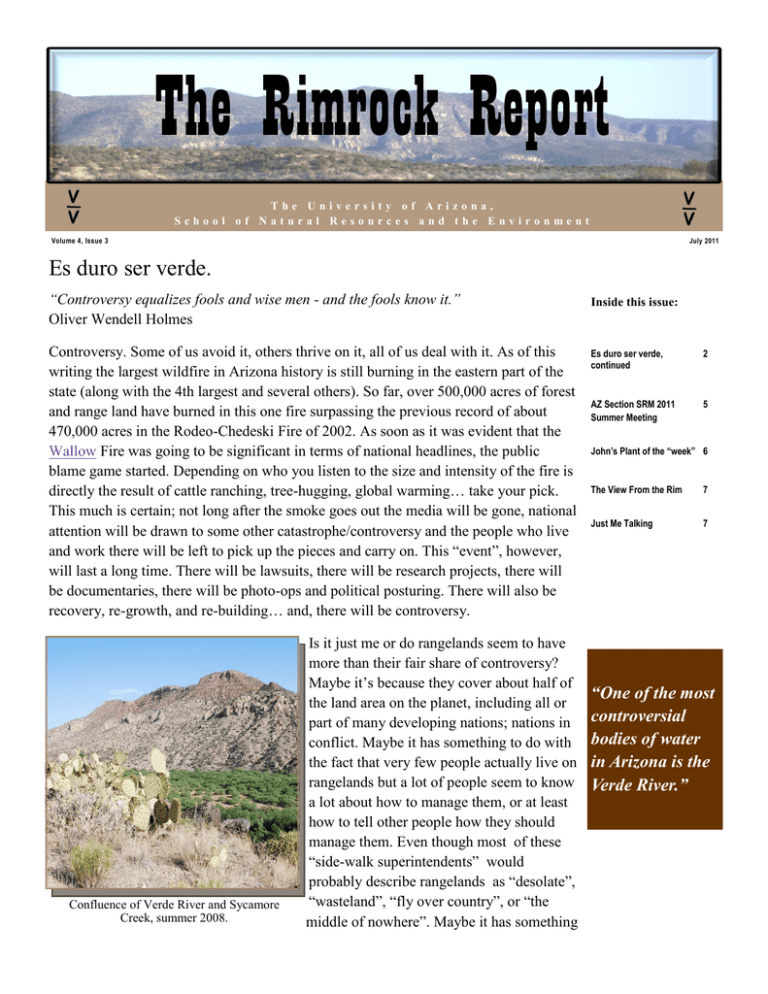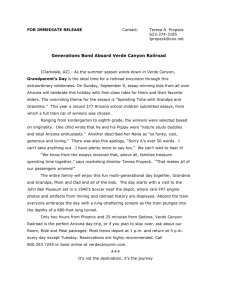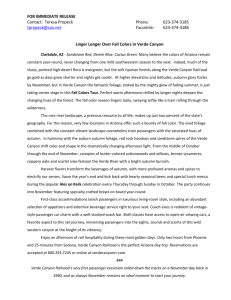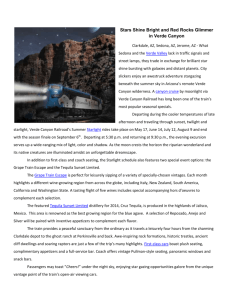The Rimrock Report
advertisement

The Rimrock Report The University of Arizona, School of Natural Resources and the Environment July 2011 Volume 4, Issue 3 Es duro ser verde. “Controversy equalizes fools and wise men - and the fools know it.” Oliver Wendell Holmes Inside this issue: Controversy. Some of us avoid it, others thrive on it, all of us deal with it. As of this writing the largest wildfire in Arizona history is still burning in the eastern part of the state (along with the 4th largest and several others). So far, over 500,000 acres of forest and range land have burned in this one fire surpassing the previous record of about 470,000 acres in the Rodeo-Chedeski Fire of 2002. As soon as it was evident that the Wallow Fire was going to be significant in terms of national headlines, the public blame game started. Depending on who you listen to the size and intensity of the fire is directly the result of cattle ranching, tree-hugging, global warming… take your pick. This much is certain; not long after the smoke goes out the media will be gone, national attention will be drawn to some other catastrophe/controversy and the people who live and work there will be left to pick up the pieces and carry on. This “event”, however, will last a long time. There will be lawsuits, there will be research projects, there will be documentaries, there will be photo-ops and political posturing. There will also be recovery, re-growth, and re-building… and, there will be controversy. Es duro ser verde, continued 2 AZ Section SRM 2011 Summer Meeting 5 Confluence of Verde River and Sycamore Creek, summer 2008. Is it just me or do rangelands seem to have more than their fair share of controversy? Maybe it’s because they cover about half of the land area on the planet, including all or part of many developing nations; nations in conflict. Maybe it has something to do with the fact that very few people actually live on rangelands but a lot of people seem to know a lot about how to manage them, or at least how to tell other people how they should manage them. Even though most of these “side-walk superintendents” would probably describe rangelands as “desolate”, “wasteland”, “fly over country”, or “the middle of nowhere”. Maybe it has something John’s Plant of the “week” 6 The View From the Rim 7 Just Me Talking 7 “One of the most controversial bodies of water in Arizona is the Verde River.” The Rimrock Report Es duro ser verde…..continued to do with the resources these lands contain: scenery, grass, wood, energy, ore…. water. Bottom line is that rangelands and the resource they hold, the goods and services they provide, are important and will probably always be a source of controversy. In the West, the item at the top of the list of competition and controversy has been and will probably always be water. One of the most coveted and controversial bodies of water in Arizona is the Verde River. The Verde River flows approximately 200 miles across the central part of the state (Figure 1), originating near Paulden in Yavapai County and eventually joining the Salt River east of Phoenix. Much of the river flows Figure 1 Major Arizona Watersheds through open rangeland which provides livestock grazing and wildlife habitat. Re-charge of this river is primarily through winter precipitation. The Verde, or more accurately a 65 mile stretch below Camp Verde, is Arizona’s only wild and scenic river and is popular with floaters, anglers, and birdwatchers. The upper Verde in particular is home to several fish species classified as Wildlife of Special Concern. These include: roundtail chub (Gila robusta), razorback sucker (Xyrauchen texanus), and spikedace (Meda fulgida). Other Verde River inhabitants which attract a lot of attention are the bald eagle (Haliaeetus leucocephalus), peregrine falcon (Falco peregrinus), southwestern willow flycatcher (Empidonax traillii extimus), and the southwestern river otter (Lontra canadensis sonora). Agricultural water is obtained from the Verde by way of several irrigation ditches and this practice dates back to the native cultures living in the Verde Valley approximately 1000 years ago. Tuzigoot National Monument is an ancient Sinagua culture pueblo built on a hill above a bend in the Verde between Clarkdale and Cottonwood. An important trade and agricultural center, approximately 200 people are thought to have lived there at one time. Today, the Verde supplies water to Phoenix and other smaller municipalities in Yavapai County including Prescott, Clarkdale, Cottonwood, and Camp Verde. These latter Page 2 The Rimrock Report Es duro ser verde…..continued communities may be smaller than Phoenix but they are found in one of the fastest growing sections of the country. The population of Yavapai County is expected double by the year 2050. With so many different resources, competing values, and just people in general, it would seem the Verde River and its’ management is a situation fraught with the possibility of controversy. I’ve heard that history repeats itself, so I guess conflict on the Verde is nothing new. This region has seen its’ share of battles through the years. For instance, Grief Hill is along an old roadway a few miles west of Camp Verde. Military records from Fort Verde indicate four different “battles” or “skirmishes” occurred in that one spot in the late 1860’s. More recently, conflicts have arisen on the upper Verde over the populations of native and non-native fishes and Verde River, winter scene north of Cottonwood, 2011. the effects of livestock grazing and groundwater pumping on these populations. Other conflicts include the effects of recreation, specifically ATV use, on river ecosystems. The Verde has sections which receive high sediment loads, and the list goes on…. The following is an excerpt from an Arizona Department of Environmental Quality report (Bowman 2001). “In 1992 the Arizona Department of Water Resources (ADWR) ranked the Verde River watershed as having the highest priority to expedite actions on pending in stream flow applications, due to the impacts imposed by the population growth of the Verde Valley (Harbour 1992). In 1984, 39.5 miles of the Verde River below Beasley Flat was designated as Wild and Scenic under the authority of the 1968 Wild and Scenic Rivers Act. In 1991 American Rivers ,one of the Nation's leading river conservation organizations, has named the Verde River one of the 15 highly threatened rivers in the U.S. This designation stems from the significance of the Verde River to the viability of the ecosystem and watershed, along with concern that guidance is needed to protect the threatened ecosystem. The largest threat to the Verde River ecosystem is ground water depletion due to increased pumping to meet water demands of rapidly growing populations in the Prescott and Verde Valley areas. Preliminary findings of a nutrient study suggest that the Verde River has limited buffering capacity, which could be affected by decreasing water quantity in the river.(40) Other threats include previous and ongoing mining operations, sand and gravel extraction, agricultural diversions, livestock grazing, urban development and associated contamination, over-use for recreational purposes, and surface water impoundments. The land uses in the greater Verde River watershed include mining, timber harvesting, ranching/grazing, commercial land uses, and a rapidly growing residential sector.” Page 3 Volume 4, Issue 3 Es duro ser verde…..continued So, yes the Verde River, flowing through the heart of Arizona and some of its’ most valued rangelands has some controversy associated with it. Who should use the river? When and what for? What effects, positive or negative do these various uses have on the river? When there is a problem, who’s to blame? Do we have data to support our claims or opinions? Well, if you are interested in the Verde, especially the upper Verde let me tell you about a unique opportunity to get out on the ground and learn firsthand about the river, its history and ecology. There will be a half day tour of the upper Verde conducted by Al Medina of the USFS Rocky Mountain Research Station just prior to the Arizona Section Society for Range Management summer meetings on August 3, 2011. Al has worked on the river for a number of years and always puts on an interesting, informative, and sometimes challenging educational experience. Information on the tour can be found following this article. So, sign up and bring your walking shoes, curiosity, and an open mind because sometimes “Es duro ser verde” (it is hard to be green). Flooded Verde River, south side of Cottonwood. Late winter/early spring 2010. Page 4 Volume 4, Issue 3 Az Section SRM Summer Meeting Upper Verde River Ecological Tour Led by Alvin L. Medina August 3, 2011, 10am to 2pm. Just before the AZ SRM Summer Meeting. Tour meeting place to be determined. Contact information for further details as they become available: phone (928)-853-1391 email almedina777@hotmail.com Potential Questions to be Addressed: 1. What are the effects of invasive plants such as Salt Cedar on the upper Verde? 2. Can cows and birds get along here? 3. Can cows and fish get along here? 4. Can native and non-native fish get along here? 5. Could there be such a thing as too many trees? On a river? 6. What are the effects of recreation on the river? Page 5 Arizona Section Society for Range Management 2011 Summer Meeting Wed. August 3 to Fri. August 5 V Bar V Ranch Summer Headquarters Near Happy Jack, Arizona Theme: Arizona Rangelands: Past, Present, and Future Agenda Registration Information Map to Ranch Map of Site Available on the V Bar V ranch website at: http://ag.arizona.edu/aes/vbarv/AzSRMSummerMeeting.html . V Bar V Summer Headquarters at Mahan Park Volume 4, Issue 3 John’s Plant of the “week” As we go to press with this edition of the Rimrock Report, John is up on Mingus Mountain with the Natural Resource Conservation Workshop for Arizona Youth. So, since he is a little busy we thought this would be a good opportunity to highlight some of the plant related publications offered by Arizona Cooperative Extension. The main webpage for extension publications is: http://cals.arizona.edu/pubs/ If you search under the subject “Natural Resource and Environment” here are a few range plant oriented publications you will find. John and students at NRCWAY 1. Arizona Range Grasses: Their Description, Forage Value, and Grazing Management (2003) Contains some informative text and line drawings of range grasses, including the headings: description, occurrence, forage value and grazing management. A nice complement to our Blue Collar Plants website. http://cals.arizona.edu/pubs/natresources/az1272/ 2. Cooperative Extension Rangeland Monitoring Program (2004) Outlines the range monitoring program developed by the university, who should participate and why. http://cals.arizona.edu/pubs/natresources/az1338.pdf 3. Dwarf Mistletoes (2011) Description of these plant parasites, their life cycle, ecology and prevention. http://cals.arizona.edu/pubs/diseases/az1309.pdf 4. How Do Domestic Herbivores Select Nutritious Diets on Rangelands? (1998) Good summary of grazing animal nutrition, and what factors affect diet selection for these animals. http://ag.arizona.edu/pubs/natresources/az1023.pdf 5. Non-Native Invasive Plants of Arizona (2009) Good compendium of information to help identify and understand invasive plants on Arizona rangelands. http://cals.arizona.edu/pubs/natresources/az1482.pdf Page 7 The view from the Rim From the once a smart@#*, always a smart @#* department…. Some of you know that I recently passed one of those landmark birthdays. Since then I have been asked several times if I feel old now, and I usually say: “…no, but I do seem to have this urge to get up early on Saturday morning, put on my coveralls, drive all the way to the coffee shop with my blinker on and tell total strangers about my surgery…” The University of Arizona School of Natural Resources and the Environment V Bar V Ranch 2830 N. Commonwealth Drive Suite 103 Camp Verde, AZ 86322 Just me talking... Phone: 928-554-8991 Fax: 928-554-8996 Cell: 928-821-3222 E-mail: dougt@cals.arizona.edu Web: http://cals.arizona.edu/aes/vbarv/ Note: Please email me if you would like to be added to the “mailing” list for this newsletter. It’s been an interesting summer so far. Since coming back from Africa I have been playing catch-up. Trying to make plans for the AZ Section SRM Summer Meeting here at the V Bar V on August 3-5. I am writing journal papers, grant proposals and trying to keep up with field work. We AI’d cows at the ranch a couple weeks ago. It has been hot recently, and windy. That has made things difficult for those fighting the Wallow, Monument, Horseshoe 2 fires and others. Weather projections are calling for a late start to the monsoon. I pray it gets here sooner but doesn’t target the White Mountains the way it seemed to hit Flagstaff last year after the Schultz Fire. Flood on top of a big fire is a difficult two-fisted punch to deal with. Nice slow rain would be good, but that is not really how monsoon rains occur unfortunately. The Natural Resource Conservation Workshop for Arizona Youth is this week on Mingus Mountain. Their focus this year is watersheds. I am sure they will also talk about fire. John Kava will be holding down the fort up there all week, training on vegetation sampling. I should be there Thursday and Friday. Jeff Schalau, Matt Livingston and I will be helping to conduct a range camp for Hopi youth later in the month of July. Jim Sprinkle, Dave Schafer, Peder Cuneo, et al recently won the applied animal science research award for their paper “Effects of a Long Acting Trace Mineral Rumen Bolus Upon Range Cow Productivity” at the Western Section American Society of Animal Science meetings in Miles City MT. The Prescott Rodeo is coming up over Fourth of July weekend. This was one of the rodeo’s I always wanted to compete in when I was younger. At least I get to see it now. Upcoming range events include the Southwestern Noxious/Invasive Weed Short Course July 26-28 in Farmington NM, the V Bar V Ranch Explorers Day on August 27 and down on campus in Tucson the Research Insights in Semi-arid Ecosystems symposium will be on October 29. . Lots of things coming up for the rest of the summer but for now, go out and enjoy the holiday and don’t forget what you’re celebrating. Till next time, Doug Page 8




